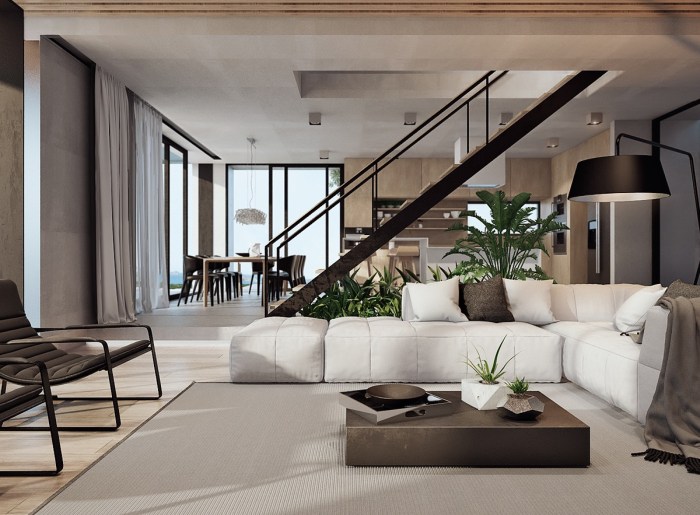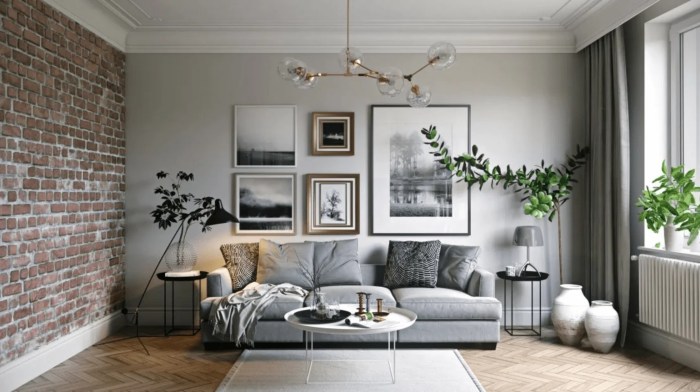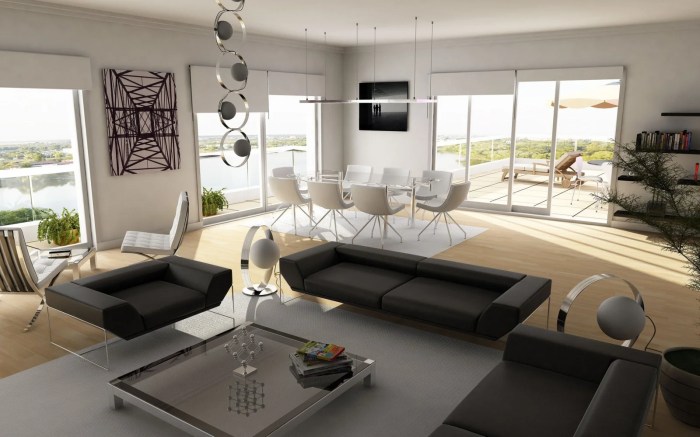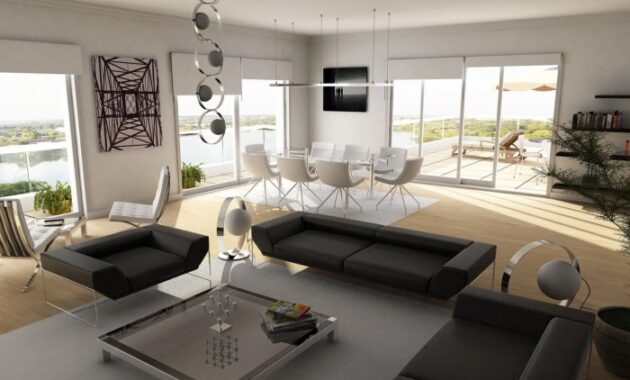Contemporary house interior design ideas are all about creating spaces that are both stylish and functional, embracing clean lines, minimalist aesthetics, and a focus on natural light. This design style celebrates modern living with a touch of warmth and sophistication, offering a refreshing alternative to traditional interiors.
Contemporary design isn’t just about trends; it’s about creating a timeless and adaptable space that reflects your personal style. It’s about embracing a balanced approach that blends functionality with visual appeal, resulting in homes that are both aesthetically pleasing and comfortable to live in.
Defining Contemporary Style

Contemporary interior design is a popular and ever-evolving aesthetic that embraces modern elements while staying true to its own unique identity. It’s about creating spaces that are both stylish and functional, reflecting the needs and tastes of the present.
Contemporary house interior design often embraces minimalism and functionality, creating spaces that feel airy and uncluttered. When dealing with smaller spaces, like a 50 square meter house interior design , clever use of space and multi-functional furniture becomes even more crucial.
However, even within these limitations, contemporary design principles can still be applied to create a stylish and welcoming home.
Key Characteristics of Contemporary Interior Design, Contemporary house interior design ideas
Contemporary design is characterized by its clean lines, minimalist approach, and focus on functionality. Here are some of its key characteristics:
- Neutral Color Palettes:Contemporary interiors often feature a neutral color palette, with a focus on shades of white, gray, beige, and black. These colors create a sense of spaciousness and allow the furniture and artwork to take center stage.
- Natural Materials:Contemporary design often incorporates natural materials such as wood, stone, leather, and metal. These materials bring warmth and texture to the space, creating a welcoming and inviting atmosphere.
- Open Floor Plans:Contemporary homes often feature open floor plans that connect different living areas, maximizing space and promoting a sense of flow.
- Minimalist Decor:Contemporary design emphasizes simplicity and functionality, avoiding unnecessary clutter. This minimalist approach creates a sense of calm and order, allowing the beauty of the space itself to shine through.
- Geometric Shapes:Geometric shapes are a common feature in contemporary design, often seen in furniture, lighting, and artwork. These shapes add a touch of sophistication and modernity to the space.
Comparing Contemporary Style with Other Design Aesthetics
Contemporary design shares similarities with other popular styles, but it also has its own distinct characteristics. Let’s compare and contrast contemporary style with modern, minimalist, and Scandinavian design:
Modern vs. Contemporary
- Modern Designis a style that originated in the early 20th century, characterized by its emphasis on functionality and clean lines. Modern design often features bold colors, geometric shapes, and a focus on industrial materials.
- Contemporary Designis a more recent style that builds upon the principles of modern design, but with a greater emphasis on comfort, warmth, and flexibility. It embraces a more relaxed and eclectic approach, allowing for a wider range of materials and colors.
Contemporary house interior design often emphasizes clean lines, minimalist aesthetics, and a focus on functionality. If you’re looking for a unique and sustainable approach, consider incorporating elements of container house interior design into your space. This style can seamlessly blend industrial elements with modern design principles, creating a truly captivating and eco-conscious living environment.
Ultimately, contemporary interior design allows for endless possibilities, making it a versatile choice for any homeowner.
Minimalist vs. Contemporary
- Minimalist Designis a style that prioritizes simplicity and functionality, focusing on reducing clutter and unnecessary elements. Minimalist interiors often feature a limited color palette, clean lines, and a focus on natural materials.
- Contemporary Designcan embrace minimalist principles, but it doesn’t necessarily require a completely bare aesthetic. Contemporary interiors can incorporate more elements and textures, creating a space that is both stylish and inviting.
Scandinavian vs. Contemporary
- Scandinavian Designis a style that emphasizes simplicity, functionality, and natural materials. Scandinavian interiors often feature light and airy spaces, with a focus on wood, leather, and wool.
- Contemporary Designshares many similarities with Scandinavian design, including its focus on natural materials and clean lines. However, contemporary design can be more eclectic and incorporate a wider range of styles and influences.
Iconic Contemporary Furniture Pieces and Designers
Contemporary design has produced many iconic furniture pieces and designers who have shaped the style. Some notable examples include:
- The Barcelona Chair by Mies van der Rohe(1929): This iconic chair, with its minimalist design and luxurious leather upholstery, is a hallmark of contemporary design. It embodies the principles of functionality and elegance, with its sleek curves and simple construction.
- The Eames Lounge Chair by Charles and Ray Eames(1956): This iconic chair, known for its comfort and elegant design, has become a staple in contemporary homes. It features a distinctive shell-like shape and is crafted from high-quality materials, such as leather and molded plywood.
- The Egg Chair by Arne Jacobsen(1958): This unique chair, with its distinctive egg-shaped design, is a testament to the innovative spirit of contemporary design. It provides privacy and comfort, while its sleek lines and minimalist design make it a stylish addition to any room.
Color Palette and Materials: Contemporary House Interior Design Ideas

Contemporary interior design is known for its clean lines, minimalist aesthetics, and emphasis on functionality. This extends to the color palette and materials used, which play a crucial role in shaping the overall ambiance and feel of a space.
Contemporary house interior design ideas often prioritize clean lines, minimalist aesthetics, and a focus on functionality. For inspiration, check out some of the best house interior design in India , which often blend modern elements with traditional Indian influences.
Whether you’re drawn to sleek modern designs or prefer a more eclectic mix, contemporary interiors can create a truly unique and inviting space.
Popular Color Palettes
Contemporary homes often feature a neutral color palette, serving as a backdrop for statement pieces and pops of color. This provides a sense of calm and spaciousness, allowing for flexibility in decorating and furniture choices.
- Monochromatic:This palette utilizes variations of a single color, creating a cohesive and sophisticated look. For instance, a space might feature shades of gray, from light to dark, with accents of white or black.
- Neutral:This palette comprises colors like white, gray, beige, and black, providing a timeless and versatile base for various design styles. These colors create a sense of serenity and allow for the incorporation of vibrant accents.
- Earthy Tones:Inspired by nature, this palette features colors like brown, green, and terracotta, adding warmth and grounding to the space. These tones are often paired with neutral colors for a balanced and harmonious look.
- Bold Accents:While neutral colors dominate contemporary homes, bold accents in vibrant hues like teal, mustard yellow, or deep blue are often used to add personality and visual interest. These accents can be incorporated through furniture, artwork, or decorative elements.
Common Materials
Contemporary interior design prioritizes materials that are both aesthetically pleasing and durable. These materials often have a natural or industrial feel, adding to the modern and sophisticated aesthetic.
- Wood:A timeless and versatile material, wood adds warmth and texture to contemporary homes. It is used for flooring, furniture, and accents, often in light or dark tones to complement the color palette.
- Metal:Metal accents, such as steel, brass, or copper, add a sleek and modern touch to contemporary interiors. They are commonly used in lighting fixtures, furniture legs, and decorative elements.
- Glass:Glass is often incorporated in contemporary homes for its transparency and ability to reflect light. It is used in windows, doors, furniture, and decorative accents, creating a sense of openness and spaciousness.
- Concrete:Concrete is a popular material in contemporary design due to its industrial and minimalist aesthetic. It is often used for flooring, countertops, and walls, adding a raw and edgy touch to the space.
- Stone:Natural stone, such as marble, granite, or slate, adds a touch of luxury and sophistication to contemporary homes. It is commonly used for countertops, flooring, and accent walls.
Material Combinations
| Material Combination | Aesthetic Impact | Example |
|---|---|---|
| Wood and Metal | Warmth and sophistication, with a touch of industrial flair | A wooden dining table with metal legs, paired with leather chairs |
| Concrete and Glass | Modern and minimalist, with a sense of openness | A concrete floor with large glass windows, creating a bright and airy space |
| Stone and Metal | Luxury and elegance, with a touch of modernism | A marble countertop with stainless steel appliances, creating a sophisticated kitchen |
| Wood and Stone | Warmth and natural beauty, with a touch of rustic charm | A wooden floor with a stone fireplace, creating a cozy and inviting living room |
Conclusion

From sleek kitchens and serene bedrooms to stylish living rooms and spa-like bathrooms, contemporary house interior design ideas provide a blueprint for creating a modern and inviting home. Whether you’re looking to renovate your existing space or design a new home from scratch, these principles can guide you toward a living environment that is both beautiful and functional.
FAQ Resource
What is the difference between contemporary and modern design?
While often used interchangeably, contemporary design is more about current trends and evolving styles, while modern design refers to a specific movement that emerged in the early 20th century. Contemporary design embraces a broader range of influences and is more adaptable to personal preferences.
How can I incorporate sustainable practices into my contemporary home design?
Choose eco-friendly materials like bamboo, reclaimed wood, and recycled glass. Opt for energy-efficient appliances and lighting, and consider using natural ventilation and daylighting to reduce energy consumption.
What are some key elements of a contemporary living room?
A contemporary living room often features an open floor plan, minimalist furniture with clean lines, neutral color palettes, and natural light. A statement piece like a large artwork or a unique lighting fixture can create a focal point.

